by Bill Batson
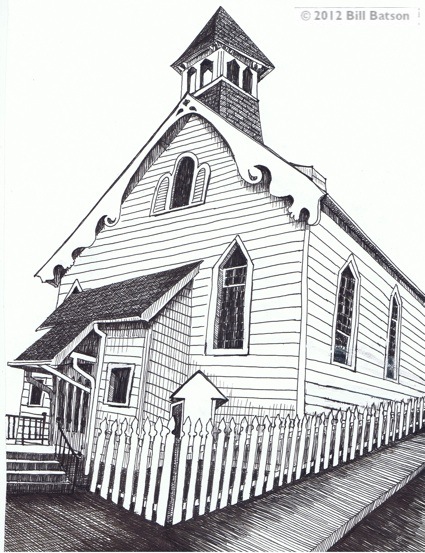 “Great nations don’t ignore their most painful moments. They don’t ignore those moments of the past. They embrace them. Great nations don’t walk away. We come to terms with the mistakes we made. And in remembering those moments, we begin to heal and grow stronger.”
“Great nations don’t ignore their most painful moments. They don’t ignore those moments of the past. They embrace them. Great nations don’t walk away. We come to terms with the mistakes we made. And in remembering those moments, we begin to heal and grow stronger.”
With these words, on June 18, 2021, President Joe Biden made Juneteenth the first Federal holiday approved by Congress since 1983, when Martin Luther King Day began. There have only been four new Federal holidays in the last 100 years, and the last two dealt with Civil Rights and Emancipation.
Juneteenth commemorates the 19th of June, 1865, when Major General Gordon Granger read General order number 3 in Galveston Texas, declaring that all slaves were free. This was two and a half years after President Lincoln’s Emancipation Proclamation had gone into effect on January 1, 1863 and two months after the fall of the Confederacy.
 June 19th was the last day for slavery in the rebel states and the death rattle of the institution as a whole. After June 19th, slavery was still completely legal and practiced in Delaware and Kentucky, loyal slave states who had not joined the Confederacy and under the terms of the Emancipation Proclamation were not targeted. Slavery would be legal there until December 6, 1865 and the ratification of the 13th amendment.
June 19th was the last day for slavery in the rebel states and the death rattle of the institution as a whole. After June 19th, slavery was still completely legal and practiced in Delaware and Kentucky, loyal slave states who had not joined the Confederacy and under the terms of the Emancipation Proclamation were not targeted. Slavery would be legal there until December 6, 1865 and the ratification of the 13th amendment.
 Some of the men who were under General Granger’s command in Texas are buried in Mount Moor Cemetery in West Nyack. Thanks to the recent restoration efforts of the Friends of the Mount Moor Cemetery, the headstones of Charles Mayo of the 46th United States Colored Troops and Logan Lafayette of the 5th Massachusetts Colored Cavalry are relatively easy to locate.
Some of the men who were under General Granger’s command in Texas are buried in Mount Moor Cemetery in West Nyack. Thanks to the recent restoration efforts of the Friends of the Mount Moor Cemetery, the headstones of Charles Mayo of the 46th United States Colored Troops and Logan Lafayette of the 5th Massachusetts Colored Cavalry are relatively easy to locate.
Mayo became the pastor of St. Philip’s AME Zion Church, which still stands, on the corner of Burd and North Mill Streets in Nyack. My great grandfather, George T. Avery was a deacon during Mayo’s tenure.
 Skeptics in the Civil Rights community did not receive the news of a the Juneteenth holiday with jubilation. Many who engaged in months of sustained protests after the murder of George Floyd wanted Congress to deliver the George Floyd Policing Bill or the John Lewis Voting Rights Act before securing the symbolic victory of a federal holiday commemorating the liberation of enslaved Africans.
Skeptics in the Civil Rights community did not receive the news of a the Juneteenth holiday with jubilation. Many who engaged in months of sustained protests after the murder of George Floyd wanted Congress to deliver the George Floyd Policing Bill or the John Lewis Voting Rights Act before securing the symbolic victory of a federal holiday commemorating the liberation of enslaved Africans.
However, with the same regularity that the acknowledgement of Martin Luther King’s birthday in January of each year injects a dosage of non-violence and racial justice into the culture of the nation, Juneteenth will provide an annual and universal recognition of the previously unacknowledged suffering of enslaved africans. The holiday also rejects the recent trend in denialism that attempts to censor the teaching of black history in our nation’s schools.
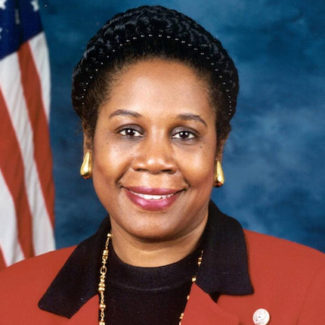
Texas Representative Sheila Jackson Lee
As sponsor of the legislation making Juneteenth a Federal holiday, Texas Congresswoman Sheila Jackson Lee was given the honor to announce the bill’s passage. “We showed America that there is unity in the understanding of our history. That history of slavery is the original sin and should never be ignored,” she said from the floor of the United States Congress.
There is no coincidence that both substantial and symbolic legislative proposals dealing with civil rights issues of critical importance are moving through Congress at this time.
Battles over Confederate flags, monuments, the national anthem and 1619 curriculum have been a persistent feature of the political and cultural landscape over the last few years. Clearly, central issues that were fought over in both the Civil War and Civil Rights Movement are unresolved in the minds of some. How we confront the symbols embedded in our statues, flags and anthems, and how we arrive at a common narrative of our history, will determine outcome of the battles on substantial legislative reform on matters of racial justice.
 Ninety year old Opal Lee, a Texas woman known as the grandmother of Juneteenth, takes a 2½-mile walk every year to commemorate the day. The distance mirrors the two and a half years it took for the Emancipation Proclamation to be enforced throughout the land. This weekend, organizers in Houston, Los Angeles, Atlanta, New York and other cities have set up walks to commemorate the day.
Ninety year old Opal Lee, a Texas woman known as the grandmother of Juneteenth, takes a 2½-mile walk every year to commemorate the day. The distance mirrors the two and a half years it took for the Emancipation Proclamation to be enforced throughout the land. This weekend, organizers in Houston, Los Angeles, Atlanta, New York and other cities have set up walks to commemorate the day.
It just so happens that the distance between Memorial Park in Nyack, where Toni Morrison dedicated a monument to abolitionist Cynthia Hesdrea and Mount Moor Cemetery is roughly 2.5 miles. If people are looking for a local route for a Juneteenth march, you could hardly find two more fitting places to start and stop.
We know about the lives of the Civil War Vets buried at Mount Moor thanks to the work of the Friends of Mount Moor Cemetery and the scholarship of Bill Stump, Junior Vice Commander of Colonel Augustus van Horne Ellis, Camp #124, Sons of Union Veterans of the Civil War.
Here are profiles of the two men in Texas on the day that we now commemorate as June 19th. If you’d like to visit the site where these men of valor are buried, Mount Moor is located in West Nyack, Adjacent to the parking lot in front Dick’s Sporting Goods Store near the Route 59 entrance across from Shoprite.
Two Witnesses to the creation of Juneteenth lay at rest at Mount Moor
There link discovered by Bill Stump, Sons of Union Army group’s
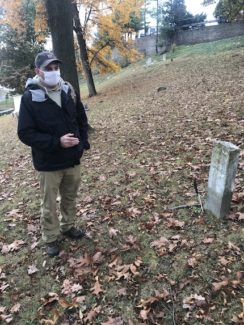
William Stump is the Junior Vice Commander of Colonel Augustus van Horne Ellis, Camp #124, Sons of Union Veterans of the Civil War
Bill Batson: what we can learn from the civil war dead buried at Mount Moor?
Bill Stump: “For the members of the United States Colored Troops (USCT), not only did they face mortal danger on the battlefield, if captured they could face summary execution like at Fort Pillow or they could be marched away from the lines into the Confederate heartland to be made into slaves. That freemen from Rockland County and escaped slaves would willingly take that gamble for America is truly astounding.
I think for today one of the lessons is the level of civic engagement we see these men take up after the war. They funded schools and churches. They communed with each other in groups like the GAR and from these connections built civil rights organizations. In our current climate of isolation even pre-COVID our fraternal organizations are dying. How can we build a healthy society in a world that we exist in working and watching Netflix?
Aside from that it’s a matter of pride, the graves of these men shouldn’t be forlorn in a parking lot. They should be visited on Veterans Day and Memorial Day. School trips should be taken to see them and hear their stories because they are inspiring. A level of engagement with the histories of our local communities makes for a more healthy country.
Friends of Mount Moor Cemetery

(l-r) William Stump, Mount Moor Cemetery Association Vice Pres., Bill Batson, Pres. Ed England, and Spring Valley NAACP President Willie Trotman.
To join our mailing list email friendsmountmoorcemetery@gmail.com
Private Logan Lafayette, Company E 5th Massachusetts Colored Cavalry
The 5th along with the 54th and 55th were black regiments created by the state of Massachusetts, because of their unique position in recruiting black soldiers before the USCT existed they attracted recruits from all over the country.
Born in Kingston, NY in about 1832, Lafayette gave his profession as cook when he enlisted at Acushnet, Massachusetts on January 24th, 1864. He was mustered into service with the 5th Mass at Camp Meigs in Readville, MA on February 10th 1864.
The unit’s name was deceptive because despite being issued mounts, by May 12, 1864 while in Maryland they had been converted to dismounted infantry and would fight like that until the end of the war.
The unit saw service in the Defenses of Washington DC until moving to City Point, Virginia and joining the siege of Petersburg in June of 1864. On the 15th the 5th fought their only pitched battle during the action at Baylor’s Farm at Second Petersburg.
As all other regiments in the XVIII Corps had been mauled at Cold Harbor, General Edward W. Hinks’ Third Division composed of black troops was selected to lead the advance. Thus, becoming the first major offensive operation undertaken by black troops in the head of the Confederate snake: Virginia.
Fighting in a heavily wooded lot surrounded by swamp protecting the Confederate earthworks on the Baylor Farm, the inexperienced troops made several costly mistakes getting bogged down by terrain. The 22nd USCT bellowed “Remember Fort Pillow!” as they assaulted the Confederate earthworks, invoking the memory of the black troops slaughtered after surrendering by Confederate troops under the command of Nathan Bedford Forrest at Fort Pillow two months prior.
The 5th Mass was kept in reserve at the start of the battle but eventually they were called into the fight losing 7 men killed and their commander Colonel Henry S. Russel wounded. After the battle, Lafayette was tasked out as company cook making use of his pre war skills. He remained on that duty from July of 1864 until November. In November he was re-designated company tailor until March 1865 when he was made cook again until the unit mustered out in October 1865.
When the Confederate capital fell in April, the 5th had the honor of being the lead regiment for XV Corps as they marched through the city. It is interesting to think what Lafayette must have seen as he marched through the capitol.
In June 1865, the 5th Mass was ordered to Texas before being mustered out at Clarksville, Texas on October 31, 1865. After the war, census records show Lafayette settling in Clarkstown and marrying Sarah Jane Lafayette and having five children. It also shows that Lafayette could read but could not write. This may explain the misspelling of his name on his tombstone reading “Layfette”. Aside from those records Lafayette’s post war history is not clearly defined. What we know is that he passed away on January 22, 1881 at age 49.
Private Charles Mayo, Company E 46th Regiment United States Colored Troops
Charles Mayo was born into slavery in Richmond, Virginia in 1833. He was sold at age 28, most likely “sold down the river” as two years later the Emancipation Proclamation found him in Helena, Arkansas. Slaves such as Mayo were sold from the upland south to the deep south sometimes in response to attempts to escape, the practice was known as being “sold down the river.”
On April 17, 1863, Mayo enlisted in the newly raised 1st Regiment Arkansas Infantry Volunteers of African Descent, this organization was redesignated as the 46th USCT on May 11, 1864. In May of 1863, the unit marched into Louisiana to provide assistance with the Siege of Vicksburg, the last Confederate stronghold on the Mississippi River. The danger for the men of the 46th was evident by their actions at a skirmish at Mound Plantation. Confederates attempting to disrupt the Vicksburg Campaign went on a massive slaving raid around Lake Providence, Louisiana. Outnumbered 10 to 1 at Mound Plantation on June 24, 1863, two companies of the 46th were captured and marched west into Louisiana and Texas and returned to a state of slavery.
As many as 1000 freedmen were captured during the course of this raid. Though Mayo’s company was not one of those captured, the very real threat not only to his life in battle but to his freedom should he be captured would not have been far from his mind.The 46th spent most of the rest of the war on defensive duty in Vicksburg, Mississippi and Memphis, Tennessee.
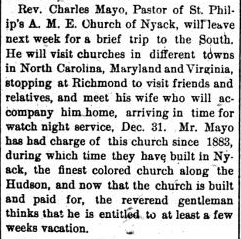 In February of 1865 they moved to New Orleans and on to duty in Texas. The unit worked on the Brazos River in Texas and the gulf coast until January 30, 1866. Among the unit’s tasks were to prevent fleeing Confederates from making it to freedom in Mexico. Mayo’s obligation came to an end at the tiny village of Boca Chica, Tx.
In February of 1865 they moved to New Orleans and on to duty in Texas. The unit worked on the Brazos River in Texas and the gulf coast until January 30, 1866. Among the unit’s tasks were to prevent fleeing Confederates from making it to freedom in Mexico. Mayo’s obligation came to an end at the tiny village of Boca Chica, Tx.
In 1885 he was named chaplain of the Silliman Post #172 of the GAR, and there we see his true passion. Charles Mayo had been a member of St. Philip’s AME Church since his arrival in Nyack and in 1886 he was named Pastor. In 1887, the Independent Advertiser carried a note that Pastor Mayo was returning to the South to visit churches and relatives. Mayo was able to walk in a preacher’s garb through a town he once would have worn chains. St. Philip’s seems to tie all the veterans resting at 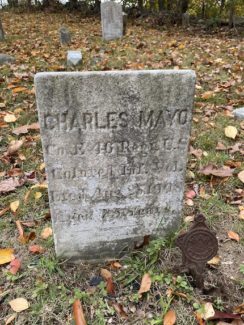 Mount Moor’s lives together. The December 8th 1888 Rockland County Journal notes that Mayo served as best man for Frank Smith who married Andrew Cason’s widow Jane at St. Philip’s. Andrew Cason who we have discussed in another entry, was also born into slavery in Virginia before joining the Union army.
Mount Moor’s lives together. The December 8th 1888 Rockland County Journal notes that Mayo served as best man for Frank Smith who married Andrew Cason’s widow Jane at St. Philip’s. Andrew Cason who we have discussed in another entry, was also born into slavery in Virginia before joining the Union army.
In 1890, Charles Mayo was named Chaplain of the newly formed Africo-American League at St.Philip’s, Benjamin Samuels was Vice President. In 1897, he was awarded a disability pension for an unknown service connected injury. Charles Mayo passed away on August 28, 1908, aged 75, at his home at 13 Liberty Street in Nyack. From enslaved in Virginia, to emancipation in Arkansas, to service in Louisiana and Texas, to a community pillar in Nyack, New York, Mayo’s life was uniquely American.
We honor his service and remember him.
- Nyack Sketch Log: Our Segregated Cemetery
- Nyack Sketch Log: St. Philip’s AME Zion Church
- Nyack Sketch Log: John Towt House
- Nyack Sketch Log: Slaves and Civil War Substitutes Fought So You Could Vote
See profiles of Civil War veterans as they are posted
Bill Batson is an activist, artist and writer who lives and sketches in Nyack, NY. “Nyack Sketch Log: Local Connection to Juneteenth” © 2017 Bill Batson.









